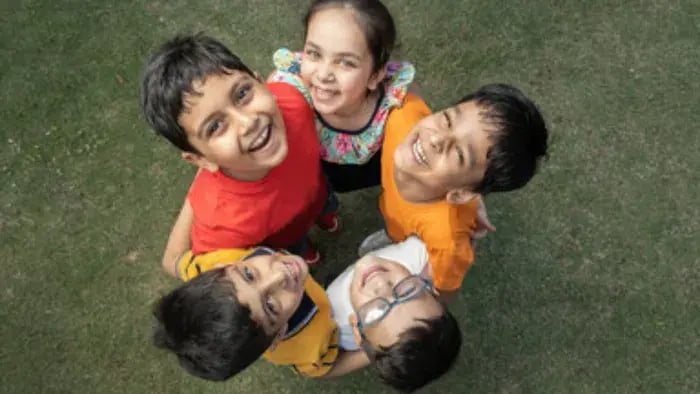- Alphabet Treasure Hunt
- Color and Shape Sorting Game
- Story Stones
- Nature Collage Art
- Number Jump Game
- Sensory Letter Tracing
- Build a Storybook
- Mystery Bag Game
- Create a Weather Chart
- Puzzle Time with a Twist
Introduction
Preschool years are full of magic, imagination and learning at lightning speed. This is the perfect time to introduce your child to simple activities that build early skills, spark creativity and encourage independent thinking. With a bit of planning and everyday objects like paper, stones, leaves and simple objects you can turn ordinary moments into learning fun.

Playful ideas like alphabet treasure hunts, nature collages, shadow play and making their own mini storybooks will help your child develop observation, memory and creative expression. Outdoor games like number hopscotch, weather charting and color hunts make learning letters, numbers and science fun and active – without the feeling of formal learning.
Beyond the fun these activities will gently help your child develop focus, problem solving skills, storytelling and confidence in trying new things. All you need is a bit of time, some natural materials from your surroundings and lots of encouragement to create meaningful and happy learning moments.
Here you’ll find 10 simple preschool activities that combine fun and learning to help your child become a curious, confident and creative learner in these early years.
10 Engaging Preschool Activities to Boost Learning and Creativity

Alphabet Treasure Hunt
Hide cut-out letters around your home or garden. Give your child a small basket and help them find each letter. As they pick one, ask them to name a word starting with it. This playful hunt sharpens letter recognition, vocabulary, and memory while keeping them moving and engaged.
Color and Shape Sorting Game
Cut out simple shapes like circles, squares, and triangles from colored paper. Mix them together. Let your child sort them by color first, then by shape. This builds early math skills, logical thinking, and fine motor skills in a hands-on, colorful way.
Story Stones
Collect a few small stones and draw simple pictures on them — a sun, a tree, a cat, a house. Let your child pick stones randomly and create their own story using the images. This fun activity boosts creativity, sequencing, and language skills while letting their imagination fly.
Nature Collage Art
During a walk, help your child collect fallen leaves, twigs, flowers, and seeds. Once home, they can glue these onto a chart paper to create their own nature collage. It improves observation, artistic skills, and builds appreciation for the world around them.
Number Jump Game
Draw numbers 1 to 10 with chalk on the ground. Call out a number and let your child jump onto it. As they get better, ask them to jump on numbers that answer simple sums like 2+3. This game strengthens number recognition, early addition, and physical coordination.
Sensory Letter Tracing
Fill a shallow tray with semolina (suji) or rice. Show your child a letter and let them trace it in the tray with their finger. This multi-sensory way of learning strengthens memory, letter formation, and tactile skills, making early writing a fun experience.
Build a Storybook
Staple a few blank papers together to create a mini book. Let your child draw simple pictures on each page, then tell you the story behind them. Write down their words under each picture. This helps develop storytelling ability, creativity, and a sense of pride in their own creation.
Mystery Bag Game
Take a cloth bag and place simple objects inside, like a toy car, a spoon, a crayon. Let your child feel inside without looking and guess the object. This activity improves sensory skills, descriptive language, and problem-solving thinking.
Create a Weather Chart
Make a simple chart with columns for Sunny, Cloudy, Rainy, and Windy. Every morning, ask your child to observe the sky and mark the weather. This builds early science skills, observation habits, and understanding of daily changes in nature.
Puzzle Time with a Twist
Use simple puzzles, jigsaw puzzles, shape sorters, or even homemade ones from cut-up pictures. To boost creativity, ask your child to mix two puzzles and create a new funny picture! This activity strengthens problem-solving, spatial thinking, and flexible thinking skills.
Conclusion

Boosting learning and creativity in preschoolers doesn't need fancy tools; it needs a little imagination, some everyday materials, and lots of encouragement. With simple activities like building storybooks, creating weather charts, and tracing letters, you are helping your child sharpen their mind, explore their creativity, and develop a lifelong love for learning.
Tarishi Shrivastava is a young writer who has covered a range of topics on children's health, including nutrition, fitness, sleep, and parent-child bonding. With a keen interest in simplifying wellness for parents, she brings a practical and engaging approach to her writing. Beyond work, she enjoys exploring new ideas, staying curious, and creating meaningful content.
The views expressed are that of the expert alone.
The information provided in this content is for informational purposes only and should not be considered a substitute for professional medical advice, diagnosis, or treatment. Always seek the advice of your physician or another qualified healthcare provider before making any significant changes to your diet, exercise, or medication routines.










